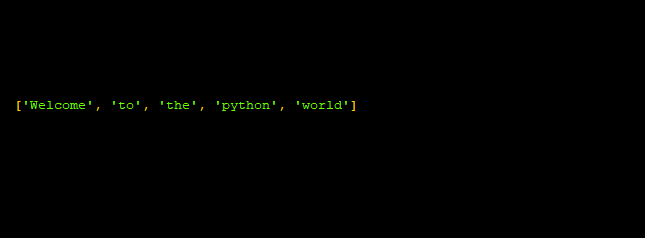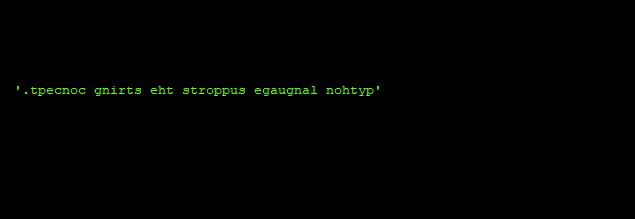Python Substring
String definition
"A string is a multiple code character/s series. The string includes a number or collection of characters that may include alphanumeric and special characters, respectively."
In Python language, strings are one of the most common styles. By literally insulating characters in quotations, we can build them. Single quotes are handled by Python similar as double quotes. It's as easy to build strings as to allocate a value to a variable.
For Example-
Pre-defined String Methods
Here, we are going to discuss some methods that are used to manipulate the strings in python. They are tabulated below-
| Sr. No. |
Method |
Description |
| 1. |
Center() |
A space-padded string with the input string positioned at the complete width of the columns is returned. |
| 2. |
Count() |
If beginning list start and stopping index stop are specified, it is used to count the number of times 'str' occurs in sequence or in a substring of string. |
| 3. |
Capitalize() |
This method is used to capitalize the first letter of string. |
| 4. |
endswith() |
Defines if a string or substring of a string finishes with a suffix (if beginning list beg and stopping index end are offered); returns true and if so wrong if not. |
| 5. |
encode() |
This method returns the encrypted string representation of the string; if a fault appears, ValueError is raised by default until errors are specified by 'ignore' or 'replace.' |
| 6. |
decode() |
This technique will allow you to use the codec authorized for encryption to decrypt a string. Advanced encoding for the standard string encoding. |
| 7. |
expandtabs() |
It is used to extend string sections to multiple spaces; if sections are not given by default, 8 spaces per section is needed. |
| 8. |
find() |
This method determines whether str takes place in a string or substring if the beginning and the ending index are returned if the index is figured and -1 otherwise. |
| 9. |
index() |
index() method works similar as like find() method but if str is not identified, therefore, it poses an exception. |
| 10. |
isalpha() |
If the sequence has at least 1 letter and all letters are alphabet or false, it returns true. |
| 11. |
isalnum() |
This method returns true if the sequence includes at least a single letter and all letters are alphanumeric and false. |
| 12. |
islower() |
This method is used to return true if the string contains only single letter and all cased letters lies in lower case; otherwise, it returns false. |
| 13. |
isdigit() |
It is used to return true if any sequence has digits otherwise, false. |
| 14. |
istitle() |
Istitle() method returns true if the sequence appropriately in 'titlecase' otherwise it returns false. |
| 15. |
isnumeric() |
It is used to return valid if there are only numeric letters in a unicode sequence, otherwise, returns false. |
| 16. |
isspace() |
If the string has only whitespace letters, this method returns true, otherwise it returns false. |
| 17. |
isupper() |
If the string contain at least single cased letter and all cased letters are in capital form, the isupper() method becomes true, otherwise it becomes false. |
| 18. |
len() |
The len() method helps you to find the size or length of the string. |
| 19. |
join() |
This function consolidates (concatenates) item sequence depictions in series seq into a string with a string separator. |
| 20. |
maketrans() |
This method will allow you to return a conversion chart for the convert operation to be used. |
| 21. |
lower() |
This will help you to transform all of the string's upper-case characters into lowercase. |
| 22. |
ljust() |
This will be used to allocate a space-padded sequence to a maximum of column widths with the initial string left-justified. |
| 23. |
istrip() |
This method will help you to eliminate all of the trailing string whitespace. |
| 24. |
replace() |
It is used to displace all existing manifestations in the string with new manifestations or, if maximum is given, maximum manifestations at most. |
| 25. |
max() |
This method is used to return the maximum alphabetical letters from the sequence str. |
| 26. |
min() |
This method is used to return the minimum alphabetical letters from the sequence str. |
| 27. |
rjust() |
It will help you to return the space-padded sequence to a maximum of column widths with the initial string right-justified. |
| 28. |
rfind() |
The working of rfind() method is similar like find() method but it searches in backward string. |
| 29. |
rindex() |
The working of rindex() function is similar like index() function but it look for the backward string. |
| 30. |
strip() |
This method is used to perform the functionality of rstrip() and lstrip() function. |
| 31. |
startswith() |
It is used to decide whether a sequence or substring sequence begins with str (if beginning index beg and finishing index end are granted); returns true if so and false if not. |
| 32. |
split() |
It is used to split sequence by substring str (storage if not supplied) and returns the substring array; if supplied, separated into a maximum number of substrings. |
| 33. |
spilitlines() |
It will be used to separate the string to all NEWLINEs (or num) and returns a list of each row with the deleted NEWLINEs. |
| 34. |
translate() |
It is used to convert strings as per the str (256 chars) in the conversion table, eliminating those in the del series. |
| 35. |
swapcase() |
The swapcase() method is used to Reverse the condition for all sequence letters. |
| 36. |
title() |
It is used to Return the string's description edition, i.e., all terms start in upper case and the remainder in lower case. |
| 37. |
isdecimal() |
It is used to return true if there are only decimal letters in the unicode sequence and false, instead. |
| 38. |
zfill() |
This method will help you to return the original left-padded sequence of zeros to a maximum of letters in width; zfill() preserves any specified signature for digits (less one zero). |
| 39. |
upper() |
This will help you to transform all of the string's lower-case characters into uppercase. |
| 40. |
rstrip() |
It is used to Eliminate all preceding sequence whitespace. |
What is a Substring
"A substring is a sequential character segment within a string in proper language analysis and computer science."
In other words, "A portion of a string is a substring. The Python string specifies several techniques for constructing a substring, checking if it includes a substring, substring index, etc."
For example, a substring of "the better of" is "It was the better of times". This is not to be mistaken with a substring, which is a substring sweeping generalization.
For instance, "Itwastimes" is a "It was the better of times" series, but not a substring.
In this document, we will explain the python substring and how it functions in the simplest terms.
We can construct a substring with the help of string slicing. We should use split() method to accomplish an array of substrings based on the mentioned delimiter.
Syntax
The syntax of string creation in python is given below-
Here, the index starts from 0.
Example
Output:
After the successful execution of the code, we got the below-mentioned screen.

- Checking if we found the substring
We can use the method find() or in operator to evaluate whether the substring is available in the sequence or not.
Syntax
The syntax of checking substring that it will lie in the string or not is given below-
Here, the find() method returns the index of substring's position, if it is matched, otherwise it will return -1.
Example Code
- Checking of substring occurrence
We can identify the number of iterations of a substring in the array using the count () method.
Syntax
The syntax of checking the occurrence of substring that it lies in the string is given below-
Example code
Output
We got the following output, after the execution of the above code.

- All indexes finding in substring
Python language does not have any built-in function to get the array of all the sub-string index values. After all, using the find() method, we can simply achieve one.
Syntax
The syntax of finding all the indexes of substring is given below-
Example code
Output:
After the successful execution of the above program code, we got the following output.

- Slicing with the help of start-index without end-index
This gets back a sliced string starting from position 5 of the array until the last of the python sequence.
Syntax
The syntax for slicing of substring through start-index without end-index is given below-
Example code
Output
After the execution of the above code, we got the below screen.

- Slicing with the help of end-index without start-index
This returns a sliced string from the beginning to the end-index-1.
Syntax
The syntax for slicing of substring via end-index without start-index is given below-
Example code
Output
After the execution of the above code, we got the below screen.

- Slicing with the complete string
It helps you to get the whole string as output.
Syntax
The syntax for slicing of whole substring is shown below-
Example code
Output
After the execution of the above code, we got the below screen.

- Slicing a single character from a string
This gets back a single character of substring from a string.
Syntax
The syntax for slicing of a single character from the string is shown below-
Example code
Output
After the successful execution of the above code, we got the following output.

- Reverse a string with the help of negative (-) step
It will help you to return the string in reverse order.
Syntax
The syntax for slicing of a reverse substring of the string is shown below-
Example code
Output
After the successful execution of the above program code, we got the below output.

Working of negative index
The working functionality of a negative index is demonstrated in the below table-
|
P |
Y |
T |
H |
O |
N |
| 0 |
1 |
2 |
3 |
4 |
5 |
| -5 |
-4 |
-3 |
-2 |
-1 |
-0 |
Here, in the above table, we take a word Python to demonstrate the exactly working functionality of the negative index.
- Slicing of a string with the help of negative (-) index
It is used to slice or substring the string with the help of negative index. The sequence index begins from 0 to 5, and we'll utilize a negative index as well.
Syntax
The syntax for slicing of a string with the help of negative index is shown below-
Example code
Output
After the successful execution of the above program code, we got the below output.

- Slicing of a string with the help of positive (+) index
It is used to slice or substring the string with the help of positive index.
Syntax
The syntax for slicing of a string with the help of positive index is shown below-
Example code
Output
After the successful execution of the above program code, we got the below output.

- Retrieving all substring with the help of list comprehension
It returns the complete substrings of a string with the help of string slicing and list comprehension.
Example code
Output
After the successful execution of the above program code, we got the below output.

- Retrieving all substring with the help of itertools.combination() method
It returns the complete substrings of a string with the help of string slicing and list comprehension.
Example code
Output
After the successful execution of the above program code, we got the below output.

| 











 For Videos Join Our Youtube Channel: Join Now
For Videos Join Our Youtube Channel: Join Now










